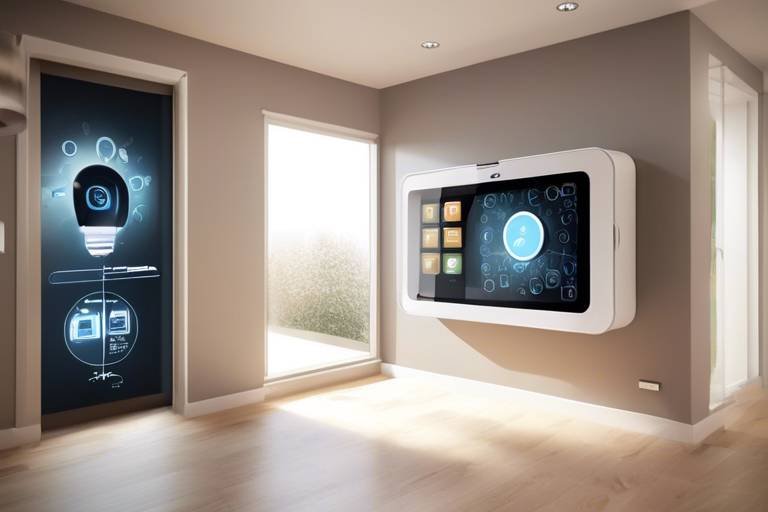How Telemedicine is Revolutionizing Healthcare
In recent years, telemedicine has emerged as a game-changer in the healthcare sector, fundamentally altering how patients and providers interact. Imagine being able to consult with a doctor from the comfort of your home, avoiding long wait times and the hassle of commuting. This is not just a dream; it's a reality that has become increasingly accessible, especially during the pandemic. Telemedicine leverages technology to bridge the gap between healthcare providers and patients, making healthcare more accessible and efficient than ever before.
The transformative impact of telemedicine is evident in various aspects of healthcare delivery. From virtual consultations to remote monitoring, the possibilities are endless. The technology behind telemedicine includes video conferencing tools, mobile health applications, and secure messaging platforms that allow for seamless communication. This evolution has not only improved patient outcomes but has also paved the way for innovative healthcare solutions that cater to diverse needs.
As we delve deeper into this topic, we will explore the myriad benefits that telemedicine brings to the table, the challenges it faces, and its future potential. The journey of telemedicine is akin to riding a roller coaster—full of twists, turns, and unexpected surprises. Buckle up as we navigate through this exciting landscape!
Telemedicine's rise can be traced back to its humble beginnings, but it has gained unprecedented momentum in recent years. Initially, it was primarily used for remote consultations in rural areas, but the COVID-19 pandemic acted as a catalyst, propelling its adoption across the globe. Suddenly, healthcare systems were forced to adapt quickly to ensure continuity of care while minimizing the risk of virus transmission.
Today, telemedicine encompasses a wide range of services, including primary care, mental health services, and chronic disease management. Patients can now access healthcare professionals through their smartphones or computers, breaking down geographical barriers that once limited access to specialists. This shift has not only improved healthcare delivery but has also empowered patients to take charge of their health.
So, what exactly are the benefits of telemedicine? The advantages are numerous, and they significantly impact both patients and healthcare providers. Here are some key benefits:
- Increased Access to Care: Patients can consult with healthcare providers regardless of their location, making it easier for individuals in remote areas to receive care.
- Convenience: Telemedicine allows patients to schedule appointments at their convenience, eliminating the need for long waits in crowded waiting rooms.
- Cost Savings: By reducing the need for in-person visits, telemedicine can lower healthcare costs for both patients and providers.
These benefits have profound implications for patient care, enhancing the overall healthcare experience. Imagine being able to consult with a specialist without the need to travel hours or wait weeks for an appointment. This level of convenience is transforming how we think about healthcare.
One of the standout features of telemedicine is its ability to connect patients with specialists, regardless of their geographical location. This is particularly beneficial for individuals with complex medical conditions that require expert opinions. With just a few clicks, patients can schedule virtual consultations with leading specialists, gaining access to cutting-edge treatments and expert advice that would otherwise be out of reach.
For patients living in rural areas, accessing healthcare can feel like climbing a mountain. Limited local resources often mean long drives to see a doctor or, worse, going without necessary care. Telemedicine acts as a lifeline, providing essential services to these underserved populations. By utilizing telehealth platforms, patients can receive timely consultations, follow-ups, and even mental health support without the burden of travel.
In emergency situations, every second counts. Telemedicine ensures that patients can connect with healthcare professionals immediately, facilitating timely interventions that can make all the difference. Whether it's a sudden allergic reaction or a mental health crisis, the ability to consult a doctor via telemedicine can lead to faster diagnoses and improved patient outcomes in critical situations.
Despite its many advantages, telemedicine is not without challenges. Regulatory issues, technology barriers, and concerns about data privacy can hinder its effectiveness. Addressing these obstacles requires collaboration between healthcare providers, technology companies, and policymakers to create a robust framework that supports safe and effective telemedicine practices.
The future of telemedicine is bright, with technological advancements paving the way for even more innovative solutions. Emerging trends such as the integration of artificial intelligence and machine learning are set to revolutionize telemedicine further, enhancing diagnostics and patient monitoring.
Artificial intelligence has the potential to transform telemedicine by providing personalized care and improving patient outcomes. For instance, AI algorithms can analyze patient data to identify trends and predict potential health issues before they escalate. This proactive approach to healthcare can lead to better management of chronic diseases and improved overall patient health.
As telemedicine continues to evolve, so do the policies governing it. Establishing clear regulatory frameworks is crucial to ensuring that telemedicine practices are safe, effective, and accessible to all. Policymakers must work collaboratively with healthcare professionals to create guidelines that protect patient privacy while promoting innovation.
1. What is telemedicine?
Telemedicine is the use of technology to provide healthcare services remotely, allowing patients to consult with healthcare providers through video, phone, or messaging.
2. Is telemedicine as effective as in-person visits?
In many cases, telemedicine can be just as effective as in-person visits, especially for routine check-ups, follow-ups, and mental health consultations.
3. What technology do I need for telemedicine?
Most telemedicine services require a smartphone, tablet, or computer with an internet connection and a camera.
4. Are telemedicine services covered by insurance?
Coverage for telemedicine varies by insurance provider and plan, so it's essential to check with your insurer to understand your benefits.
5. Can I get prescriptions through telemedicine?
Yes, many telemedicine providers can prescribe medications during virtual consultations, depending on the patient's needs and local regulations.

The Rise of Telemedicine
Telemedicine has rapidly gained traction in recent years, especially during the pandemic, when traditional healthcare delivery faced unprecedented challenges. Imagine a world where you can consult a doctor without stepping out of your home; this is no longer a distant dream but a reality brought to life by telemedicine. The evolution of this innovative approach to healthcare has been nothing short of remarkable. It combines advanced technology with a need for accessible medical care, transforming the way we think about doctor visits. From video consultations to remote monitoring, telemedicine has changed the landscape of healthcare delivery.
The technology behind telemedicine is a blend of software and hardware solutions designed to facilitate remote healthcare services. High-speed internet, smartphones, and secure video conferencing platforms have paved the way for this revolution. Patients can now connect with healthcare providers through various devices, making healthcare more accessible than ever. As we delve deeper into this topic, it’s essential to understand how telemedicine has evolved from a niche service to a mainstream solution, especially in the wake of global health crises.
Before the pandemic, telemedicine was often viewed as a supplementary option, primarily utilized in specific situations. However, as the world grappled with lockdowns and social distancing measures, healthcare providers quickly adapted to this new reality. The need for safe, effective, and timely medical care became paramount, leading to a surge in telemedicine adoption. According to a recent study, telehealth visits increased by over 154% in March 2020 compared to the previous year. This explosive growth not only showcased the demand for remote healthcare but also highlighted the potential of telemedicine to bridge gaps in traditional healthcare systems.
With this rapid rise came a new set of challenges and opportunities. Healthcare providers faced the task of integrating telemedicine into their existing practices, while patients had to adapt to new ways of seeking care. This transformation has led to a more patient-centric approach, where individuals can receive care on their terms. The convenience of scheduling appointments, accessing medical records, and communicating with healthcare professionals has made telemedicine an attractive option for many.
As we look ahead, it’s essential to recognize that the rise of telemedicine is not just a temporary shift; it represents a fundamental change in how healthcare is delivered. The ongoing advancements in technology, coupled with changing patient expectations, suggest that telemedicine will continue to play a crucial role in the future of healthcare. By breaking down geographical barriers and offering flexible care options, telemedicine is truly revolutionizing the way we access health services.
In summary, the rise of telemedicine marks a pivotal moment in healthcare history. It is a testament to human ingenuity and resilience, demonstrating how technology can enhance patient care and accessibility. As we embrace this new era of healthcare delivery, it is vital to continue exploring the benefits and challenges that come with it, ensuring that we maximize its potential for all.
- What is telemedicine? Telemedicine refers to the use of technology to provide medical care remotely, allowing patients to consult with healthcare providers without needing to be physically present.
- How has telemedicine changed healthcare delivery? Telemedicine has made healthcare more accessible by eliminating geographical barriers, providing convenience, and offering flexible care options.
- What technology is used in telemedicine? Telemedicine utilizes various technologies, including video conferencing, mobile apps, and remote monitoring devices, to facilitate patient-provider interactions.
- Is telemedicine effective? Yes, studies have shown that telemedicine can be as effective as in-person visits for many conditions, improving patient outcomes and satisfaction.

Benefits of Telemedicine
Telemedicine is not just a buzzword; it's a game-changer in the healthcare landscape. Imagine being able to consult a doctor from the comfort of your home, without the hassle of traffic or long waiting times. That's the beauty of telemedicine—it brings healthcare to your fingertips! One of the most significant benefits of telemedicine is its ability to increase access to care. Patients no longer have to travel long distances to see specialists; instead, they can connect with healthcare providers via video calls or online chats. This is particularly beneficial for individuals living in remote areas where healthcare facilities are scarce.
Furthermore, telemedicine offers unparalleled convenience for patients. Picture this: you wake up feeling under the weather, and instead of sitting in a waiting room filled with other sick patients, you can simply log onto your computer or smartphone and have a consultation within minutes. This easy access not only saves time but also reduces exposure to illnesses that can be caught in traditional waiting rooms. It's like having a personal healthcare assistant available 24/7!
Cost savings are another critical advantage of telemedicine. Traditional healthcare visits often involve various expenses, including transportation, time off work, and even childcare. With telemedicine, many of these costs are eliminated. In fact, a recent study showed that telemedicine can reduce healthcare costs by as much as 30%. This is a win-win situation for both patients and healthcare providers, as it allows for more efficient use of resources.
Moreover, telemedicine significantly enhances the ability to access specialists. In the past, if you needed to see a specialist, you might have had to wait weeks or even months for an appointment. Now, with just a few clicks, you can consult with leading experts in various fields without geographical limitations. This is particularly crucial for patients with complex health issues who require specialized care. For example, a patient in a small town can easily connect with a renowned cardiologist located in a major city, improving their chances of receiving timely and effective treatment.
Another area where telemedicine shines is in providing rural healthcare solutions. Patients living in rural areas often face unique challenges, such as limited access to healthcare facilities and providers. Telemedicine bridges this gap, offering essential services like routine check-ups, mental health consultations, and chronic disease management. By utilizing telemedicine, healthcare providers can reach underserved populations, ensuring that everyone has access to quality care, regardless of their location.
In emergencies, the ability to access care quickly can be a matter of life and death. Telemedicine facilitates immediate consultations, allowing healthcare professionals to assess situations swiftly and provide guidance. For instance, if someone experiences chest pain, a telemedicine consultation can provide immediate advice on whether to seek emergency care. This kind of rapid response can significantly improve patient outcomes, ensuring that critical care is delivered when it's needed most.
In conclusion, the benefits of telemedicine are numerous and far-reaching. From improved access to specialists and rural healthcare solutions to cost savings and emergency care accessibility, telemedicine is reshaping the way we think about healthcare delivery. As technology continues to advance, we can expect even more innovative solutions to emerge, further enhancing the patient experience.
- What is telemedicine? Telemedicine is the use of technology to provide remote healthcare services, allowing patients to consult with healthcare providers without needing to visit a clinic in person.
- How does telemedicine improve access to specialists? Telemedicine allows patients to connect with specialists from anywhere, eliminating geographical barriers and reducing wait times for appointments.
- Is telemedicine cost-effective? Yes! Telemedicine can significantly reduce costs associated with traditional healthcare visits, such as travel expenses and time off work.
- Can I receive emergency care through telemedicine? Absolutely! Telemedicine can facilitate immediate consultations in emergencies, helping healthcare providers assess situations quickly and provide guidance.

Improved Access to Specialists
Imagine living in a small town where the nearest specialist is hours away, and making that trip feels like climbing a mountain just to get a check-up. Telemedicine has turned that scenario on its head, providing patients with the ability to consult with specialists without the hefty travel expenses or time-consuming journeys. This transformation is nothing short of revolutionary, as it breaks down geographical barriers that once limited access to quality healthcare. Now, patients can connect with top-notch specialists from the comfort of their own homes, making healthcare not just a service, but a truly accessible experience.
The beauty of telemedicine lies in its ability to connect patients with a vast network of specialists across various fields, from dermatology to cardiology. With just a few clicks, individuals can schedule virtual appointments, receive expert opinions, and even follow-up consultations without the hassle of waiting weeks for an in-person visit. This immediate access not only enhances patient satisfaction but also plays a crucial role in early diagnosis and treatment of medical conditions. For instance, a patient experiencing unusual symptoms can quickly consult a specialist, potentially leading to earlier interventions that can save lives.
Moreover, the impact of telemedicine on patient care is profound. It allows for a more personalized approach, as specialists can review patient histories and discuss treatment options in real-time. This level of interaction fosters a stronger relationship between patients and healthcare providers, making patients feel more engaged and informed about their health. In fact, studies have shown that when patients have easy access to specialists, they are more likely to adhere to treatment plans and follow through with necessary medical advice.
To illustrate this point, consider the following table that outlines the advantages of improved access to specialists through telemedicine:
| Advantage | Description |
|---|---|
| Reduced Travel Time | Patients can consult specialists without the need for long-distance travel. |
| Increased Convenience | Appointments can be scheduled at flexible times, fitting into patients' busy lives. |
| Broader Specialist Network | Access to a wide range of specialists, regardless of location. |
| Enhanced Patient Engagement | Patients can communicate more easily with specialists, fostering better health outcomes. |
As we look to the future, the role of telemedicine in improving access to specialists will only grow. With advancements in technology, we can expect even more innovative solutions that will enhance this accessibility. Imagine virtual reality consultations or AI-driven diagnostics that can provide immediate feedback and recommendations. The possibilities are endless!
In conclusion, telemedicine is not just a trend; it is a vital aspect of modern healthcare that is reshaping how we access specialist care. By eliminating barriers and providing immediate, convenient access to top professionals, telemedicine is setting a new standard for patient care. The question now is, are you ready to embrace this change and take charge of your health?
- What is telemedicine? Telemedicine refers to the use of technology to provide healthcare services remotely, allowing patients to consult with healthcare providers via video calls, phone calls, or messaging.
- How does telemedicine improve access to specialists? It eliminates geographical barriers, enabling patients to connect with specialists regardless of their location, thus enhancing healthcare accessibility.
- Are telemedicine consultations as effective as in-person visits? Yes, many studies indicate that telemedicine consultations can be equally effective, especially for follow-ups and non-emergency situations.
- What technology do I need for a telemedicine appointment? Typically, you will need a device with internet access, such as a smartphone, tablet, or computer, along with a webcam and microphone for video consultations.

Rural Healthcare Solutions
Accessing healthcare in rural areas has always been a daunting challenge. Imagine living miles away from the nearest hospital, where a simple check-up could mean a long drive on bumpy roads. This scenario is all too familiar for many individuals residing in remote locations. However, telemedicine is stepping in to change the game, providing a lifeline to those who previously faced significant barriers to receiving care. With the advent of telehealth services, patients can now connect with healthcare providers from the comfort of their homes, effectively eliminating the need for extensive travel.
One of the most significant advantages of telemedicine in rural healthcare is that it bridges the gap between patients and specialists. In many cases, rural residents may not have easy access to specialists, leading to delays in diagnosis and treatment. Through telemedicine, patients can schedule virtual appointments with experts in various fields, regardless of their location. This means that whether you're in a small town or a remote village, you can receive care from top-notch professionals.
The implications of this are profound. For instance, patients suffering from chronic conditions such as diabetes or heart disease can benefit immensely from regular consultations with specialists who can monitor their health remotely. This accessibility not only enhances the quality of care but also leads to better health outcomes. In fact, a study by the American Telemedicine Association found that telemedicine can reduce hospital admissions by up to 20% in rural populations.
Moreover, telemedicine plays a crucial role in emergency situations. In rural areas, every second counts, and the ability to consult with a healthcare provider immediately can be life-saving. Imagine a scenario where someone suffers a heart attack or a severe injury; telemedicine allows for instant access to medical advice, even before the ambulance arrives. This rapid response can significantly improve survival rates and outcomes for patients facing critical health issues.
However, it’s essential to recognize that while telemedicine offers numerous benefits, there are still challenges that need addressing. For example, many rural areas may lack reliable internet access, which can hinder the effectiveness of telehealth services. To tackle this issue, initiatives aimed at improving broadband connectivity in underserved regions are crucial. As these technological barriers are overcome, the potential for telemedicine to transform rural healthcare becomes even more significant.
In conclusion, telemedicine is not just a trend; it is a revolutionary approach to healthcare that is particularly beneficial for rural populations. By enhancing access to specialists, improving emergency care, and overcoming geographical barriers, telemedicine is paving the way for a brighter future in healthcare delivery. As we continue to embrace these technological advancements, the hope is that no one, regardless of where they live, will ever have to compromise on their health due to distance.
- What is telemedicine? Telemedicine refers to the use of technology to provide healthcare services remotely, allowing patients to consult with healthcare providers via video calls, phone calls, or messaging.
- How does telemedicine benefit rural patients? Telemedicine increases access to healthcare specialists, provides immediate care in emergencies, and reduces the need for travel, making healthcare more convenient for rural residents.
- Are there any challenges associated with telemedicine? Yes, challenges include technological barriers such as poor internet connectivity, regulatory issues, and the need for proper training for both patients and providers.
- What is the future of telemedicine? The future looks promising, with advancements in technology, integration with AI, and evolving regulations that aim to enhance the effectiveness and accessibility of telemedicine services.

Emergency Care Accessibility
In today's fast-paced world, the importance of immediate access to emergency care cannot be overstated. Imagine a scenario where a loved one suddenly collapses or experiences severe chest pain. In such critical moments, every second counts. Telemedicine emerges as a vital lifeline, providing an avenue for patients to connect with healthcare professionals instantly, regardless of their location. This capability is especially crucial in rural or underserved areas where hospitals may be miles away.
Telemedicine platforms enable patients to consult with emergency specialists through video calls or secure messaging, allowing for rapid assessment and guidance. This not only alleviates anxiety for patients and their families but also ensures that they receive timely advice on whether to visit an emergency room or manage their symptoms at home. In fact, studies have shown that telemedicine can significantly reduce wait times for consultations in emergency situations, leading to quicker interventions and better outcomes.
Moreover, telemedicine facilitates a more streamlined approach to emergency care. For example, consider the following benefits:
- Immediate Triage: Patients can be triaged remotely, determining the urgency of their condition without the need for physical presence, which can save precious time.
- Access to Specialists: In cases where specialized knowledge is required, telemedicine allows for quick consultations with experts who may not be locally available.
- Continuity of Care: Follow-up consultations can be easily scheduled through telemedicine platforms, ensuring that patients continue to receive the care they need even after the initial emergency has passed.
Furthermore, the integration of telemedicine in emergency care has proven beneficial during public health crises, such as the COVID-19 pandemic. Hospitals faced overwhelming patient loads, and telemedicine helped divert non-critical cases away from emergency rooms, allowing healthcare providers to focus on those in dire need. This not only improved patient outcomes but also helped to reduce the risk of virus transmission in crowded settings.
As we look to the future, the potential for telemedicine in emergency care is vast. With ongoing advancements in technology, we can expect even more robust systems that enhance patient safety and accessibility. For instance, the incorporation of artificial intelligence could lead to better predictive analytics, helping healthcare providers anticipate emergencies before they escalate. In essence, telemedicine is not just a temporary solution; it is reshaping the landscape of emergency care accessibility, ensuring that help is always just a click away.
- What is telemedicine? Telemedicine refers to the use of technology to provide medical care remotely, allowing patients to consult with healthcare professionals through video calls, phone calls, or messaging.
- How does telemedicine improve emergency care? It provides immediate access to healthcare professionals, enabling quick assessments, triaging, and consultations with specialists, which can save lives in critical situations.
- Are there any limitations to telemedicine? Yes, while telemedicine is beneficial, it may not be suitable for all emergencies, particularly those requiring physical examinations or immediate interventions.

Challenges of Telemedicine
While telemedicine has ushered in a new era of healthcare accessibility, it is not without its challenges. One of the primary hurdles is the regulatory landscape, which can vary significantly from one region to another. As telemedicine crosses state and national borders, providers often find themselves navigating a complex web of laws and regulations. This can lead to confusion and inconsistency in care delivery. For instance, some states may require specific licenses for telehealth services, while others might not recognize out-of-state providers at all. This patchwork of regulations can hinder the ability of healthcare professionals to offer their services effectively.
Another significant challenge is the reliance on technology. Not everyone has access to high-speed internet or the necessary devices to engage in telemedicine consultations. This digital divide can exacerbate existing inequalities in healthcare access, particularly among older adults or those living in rural areas. In fact, a recent study indicated that approximately 25% of rural households lack reliable internet access, which can prevent patients from receiving timely care. Moreover, even when patients have the technology, they may lack the technical know-how to navigate telehealth platforms, leading to frustration and missed appointments.
Additionally, there are concerns about the quality of care delivered through virtual visits. While telemedicine can be a convenient option, it may not be suitable for all medical conditions. Certain diagnoses require in-person examinations, and the inability to conduct physical assessments can lead to misdiagnosis or inadequate treatment plans. For instance, a patient experiencing chest pain might need an immediate physical evaluation to rule out serious conditions, something that a video call simply cannot provide.
Moreover, the security of patient information is a critical issue in telemedicine. With the increasing number of cyber attacks targeting healthcare systems, patients may feel uneasy about sharing sensitive information over digital platforms. Healthcare providers must prioritize data privacy and invest in robust cybersecurity measures to protect patient data, which can be both costly and complex to implement.
Lastly, reimbursement policies for telemedicine services remain inconsistent. While many insurers have expanded their coverage for telehealth visits, some still do not recognize these services at the same level as in-person visits. This discrepancy can deter healthcare providers from fully embracing telemedicine, as they may fear financial losses. As telemedicine continues to evolve, it is crucial for lawmakers and insurers to establish clear and equitable reimbursement policies to encourage wider adoption.
- What are the main challenges of telemedicine?
The main challenges include regulatory hurdles, technology access, quality of care concerns, data security issues, and inconsistent reimbursement policies. - How can patients ensure they have access to telemedicine?
Patients can check with their healthcare providers about available telehealth options and ensure they have the necessary technology and internet access. - Is telemedicine as effective as in-person visits?
While telemedicine can be effective for many conditions, some situations require in-person evaluations for accurate diagnosis and treatment.

Future of Telemedicine
As we gaze into the crystal ball of healthcare, the shines brightly with promise and potential. Technological advancements are not just knocking at the door; they are barging in, ready to reshape how we interact with healthcare providers. Imagine a world where you can consult with a doctor from the comfort of your home, with just a few taps on your smartphone. This isn’t science fiction; it’s the reality we are rapidly moving towards. The integration of cutting-edge technologies such as artificial intelligence (AI) and machine learning is set to revolutionize the telemedicine landscape, making healthcare more personalized and efficient.
AI and machine learning are not just buzzwords; they are powerful tools that can analyze vast amounts of data to provide insights that were previously unimaginable. For instance, imagine a scenario where an AI system can monitor your health metrics in real-time, alerting your healthcare provider if it detects any anomalies. This could lead to earlier interventions and better patient outcomes. Furthermore, with the rise of wearable technology, patients can now track their vital signs continuously, feeding this data back to their doctors. This creates a dynamic feedback loop that enhances the quality of care.
Moreover, the regulatory landscape surrounding telemedicine is evolving. As telemedicine becomes more mainstream, the need for robust policies and regulations grows. Governments and healthcare organizations are recognizing the importance of establishing guidelines that ensure safe, secure, and effective telemedicine practices. This includes addressing issues such as patient privacy, data security, and licensing for healthcare providers who offer telehealth services across state lines. A well-structured regulatory framework will not only protect patients but also foster trust in telemedicine services.
In addition to AI and regulatory developments, we can expect to see a surge in patient engagement tools. These tools will empower patients to take an active role in their healthcare journey. For example, platforms that allow patients to easily schedule appointments, access their medical records, and communicate with their healthcare providers will become more prevalent. This shift towards patient-centered care is crucial, as it encourages individuals to be proactive about their health, ultimately leading to better outcomes.
As we look ahead, it's clear that telemedicine is not just a temporary solution; it is a fundamental shift in how we approach healthcare. The potential benefits are immense, but we must also remain vigilant about the challenges that lie ahead. By embracing innovation and adapting to the changing landscape, we can ensure that telemedicine fulfills its promise of making healthcare more accessible, efficient, and personalized for everyone.
- What is telemedicine?
Telemedicine refers to the use of technology to provide healthcare services remotely, allowing patients to consult with healthcare providers without needing to be physically present. - How does telemedicine improve access to care?
Telemedicine eliminates geographical barriers, enabling patients, especially those in rural or underserved areas, to consult specialists and receive timely care. - What are the challenges associated with telemedicine?
Challenges include regulatory issues, technology barriers, and concerns regarding patient privacy and data security. - How is AI used in telemedicine?
AI can enhance diagnostics, monitor patient health in real-time, and provide personalized care recommendations based on data analysis.

Integration with AI and Machine Learning
The integration of Artificial Intelligence (AI) and Machine Learning (ML) into telemedicine is not just a trend; it’s a game changer. Imagine having a virtual assistant that can analyze your symptoms, suggest possible diagnoses, and even recommend treatments—all from the comfort of your home. This is the future that AI and ML are paving in the realm of healthcare. By leveraging vast amounts of data, these technologies can identify patterns and make predictions with remarkable accuracy. For instance, AI algorithms can sift through thousands of patient records to find correlations that a human might miss, leading to earlier diagnoses and tailored treatment plans.
Moreover, the use of AI in telemedicine can significantly enhance patient monitoring. Wearable devices equipped with AI capabilities can track vital signs in real-time and alert healthcare providers if any anomalies arise. This continuous monitoring is especially beneficial for patients with chronic conditions, as it allows for swift intervention before a minor issue escalates into a crisis. In essence, AI acts like a vigilant guardian, always on the lookout for potential health threats.
Additionally, AI can optimize the telemedicine experience for both patients and healthcare providers. For example, chatbots powered by AI can handle routine inquiries, schedule appointments, and provide preliminary health advice, freeing up medical professionals to focus on more complex cases. This not only improves efficiency but also enhances patient satisfaction, as individuals receive timely responses to their queries.
Furthermore, the incorporation of Machine Learning algorithms can lead to personalized medicine, where treatments are tailored to the unique genetic makeup of each patient. By analyzing genetic data alongside health records, ML can help predict how a patient might respond to a particular treatment, minimizing the trial-and-error approach that often accompanies medical care. This level of customization is akin to having a tailored suit—perfectly fitted to your needs, ensuring comfort and effectiveness.
However, the integration of AI and ML into telemedicine is not without its challenges. Issues such as data privacy, ethical considerations, and the need for robust regulatory frameworks must be addressed to ensure that these technologies are used responsibly. As we move forward, it will be crucial for stakeholders to collaborate and establish guidelines that maximize the benefits while minimizing the risks associated with AI in healthcare.
- What is the role of AI in telemedicine? AI helps analyze patient data, provide diagnosis suggestions, and enhance patient monitoring.
- How does Machine Learning personalize healthcare? Machine Learning can analyze genetic and health data to tailor treatments to individual patients.
- Are there risks associated with AI in telemedicine? Yes, concerns include data privacy, ethical issues, and the need for regulatory frameworks.

Policy and Regulation Developments
The landscape of telemedicine is not just shaped by technological advancements but also significantly influenced by . As this innovative approach to healthcare delivery gains momentum, it is crucial for governing bodies to establish frameworks that ensure both patient safety and the quality of care. In recent years, we've witnessed a surge in legislative efforts aimed at addressing the unique challenges posed by telemedicine, and these developments are pivotal for its sustainable growth.
One of the primary focuses of new regulations is the licensure of healthcare providers. Traditionally, providers needed to be licensed in the state where the patient resides. However, during the pandemic, many states enacted temporary measures to allow cross-state practice, recognizing the need for flexibility in healthcare delivery. This shift has sparked ongoing discussions about the possibility of a more permanent solution, such as the Interstate Medical Licensure Compact, which could streamline the licensure process across state lines. This would not only enhance access to specialists but also ensure that patients receive timely care, regardless of their location.
Moreover, reimbursement policies are undergoing significant changes as well. Insurers are beginning to recognize the cost-effectiveness of telemedicine, leading to more favorable reimbursement rates for virtual visits. This is a game-changer for both patients and providers, as it encourages the adoption of telehealth services. However, disparities still exist, with some insurers offering limited coverage for telemedicine services. The push for universal reimbursement policies is essential to ensure that all patients have equal access to telehealth, regardless of their insurance provider.
Regulatory bodies are also focusing on privacy and security concerns related to telemedicine. With the rise of digital health technologies, ensuring the confidentiality of patient information is paramount. Regulations like the Health Insurance Portability and Accountability Act (HIPAA) are being reinforced to adapt to the digital age, emphasizing the need for robust cybersecurity measures. Healthcare providers must implement secure platforms and educate patients on how to protect their personal health information during virtual consultations.
In addition to these developments, the integration of telemedicine into mainstream healthcare practices is being supported by various federal initiatives. For instance, the Centers for Medicare & Medicaid Services (CMS) has expanded the list of covered telehealth services, allowing for a broader range of medical consultations to be conducted remotely. This not only improves patient access but also helps in managing chronic conditions more effectively by facilitating regular check-ins without the need for in-person visits.
Looking ahead, the evolution of telemedicine will likely depend on the ability of policymakers to adapt to the rapidly changing healthcare environment. Stakeholders, including healthcare providers, patients, and technology developers, must collaborate to ensure that regulations keep pace with innovations. This collaboration can lead to the establishment of best practices and guidelines that enhance the safety and efficacy of telemedicine.
In conclusion, as telemedicine continues to evolve, the role of policy and regulation will be critical in shaping its future. By addressing licensure challenges, reimbursement disparities, privacy concerns, and integrating telehealth into standard practices, we can pave the way for a more accessible and effective healthcare system. The ongoing dialogue among policymakers, healthcare providers, and patients will be essential in navigating the complexities of telemedicine, ensuring that it serves as a valuable tool in improving health outcomes for all.
- What is telemedicine? Telemedicine refers to the use of technology to deliver healthcare services remotely, allowing patients to consult with healthcare providers without needing to visit a physical location.
- How does telemedicine improve access to care? Telemedicine eliminates geographical barriers, enabling patients, especially those in rural areas, to connect with specialists and receive timely medical attention.
- Are telemedicine services covered by insurance? Coverage for telemedicine services varies by insurer and state regulations. However, many insurers are increasingly recognizing the value of telehealth and expanding their coverage.
- What are the privacy concerns associated with telemedicine? Privacy concerns primarily revolve around the security of patient data during virtual consultations. Regulations like HIPAA are in place to protect patient information, but providers must also implement strong cybersecurity measures.
Frequently Asked Questions
- What is telemedicine?
Telemedicine is the use of technology to provide healthcare services remotely. It allows patients to consult with healthcare providers via video calls, phone calls, or messaging, making healthcare more accessible than ever.
- How has telemedicine changed healthcare delivery?
Telemedicine has transformed healthcare delivery by breaking geographical barriers, enabling patients to access specialists without the need for travel. This is especially beneficial for individuals living in rural areas or those with mobility challenges.
- What are the benefits of using telemedicine?
Some key benefits of telemedicine include increased access to care, convenience for patients, and potential cost savings. Patients can receive timely consultations and follow-ups without the hassle of commuting, which enhances overall satisfaction.
- Can telemedicine be used for emergency care?
Yes! Telemedicine can facilitate immediate consultations in emergencies, allowing healthcare providers to assess situations quickly and provide critical guidance until further care can be accessed.
- What challenges does telemedicine face?
While telemedicine offers numerous advantages, it also faces challenges such as regulatory issues, technology barriers, and concerns about the quality of care. Addressing these obstacles is vital for maximizing its potential.
- How is technology advancing telemedicine?
Technological advancements, particularly in artificial intelligence and machine learning, are set to revolutionize telemedicine. These innovations can enhance diagnostics, patient monitoring, and personalized care, making healthcare even more effective.
- What is the future of telemedicine?
The future of telemedicine looks bright, with ongoing developments in technology and policy. As regulations evolve and new tools emerge, telemedicine is expected to become an integral part of healthcare delivery.



















